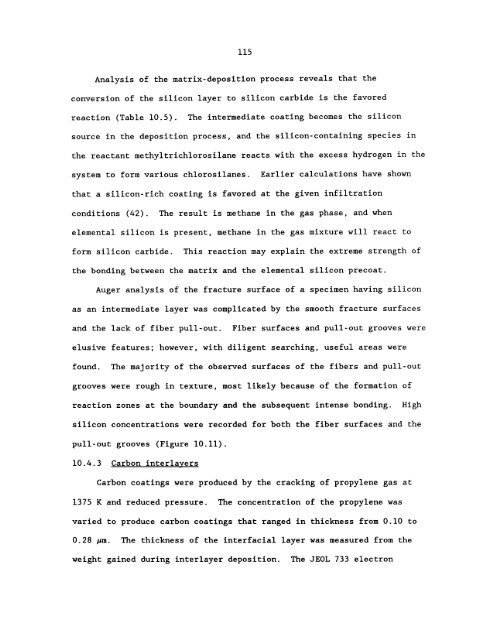Characterization and control of the fiber-matrix interface in ceramic ...
Characterization and control of the fiber-matrix interface in ceramic ...
Characterization and control of the fiber-matrix interface in ceramic ...
You also want an ePaper? Increase the reach of your titles
YUMPU automatically turns print PDFs into web optimized ePapers that Google loves.
115<br />
Analysis<br />
conversion <strong>of</strong><br />
<strong>of</strong> <strong>the</strong> <strong>matrix</strong>-deposition process reveals that <strong>the</strong><br />
<strong>the</strong> silicon layer to silicon carbide is <strong>the</strong> favored<br />
reaction (Table 10.5).<br />
The <strong>in</strong>termediate coat<strong>in</strong>g becomes <strong>the</strong> silicon<br />
source <strong>in</strong> <strong>the</strong> deposition process, <strong>and</strong> <strong>the</strong> silicon-conta<strong>in</strong><strong>in</strong>g species <strong>in</strong><br />
<strong>the</strong> reactant methyltrichlorosilane reacts with <strong>the</strong> excess hydrogen <strong>in</strong> <strong>the</strong><br />
system to form various chlorosilanes.<br />
Earlier calculations have shown<br />
that a silicon-rich coat<strong>in</strong>g is favored at <strong>the</strong> given <strong>in</strong>filtration<br />
conditions (42).<br />
The result is methane <strong>in</strong> <strong>the</strong> gas phase, <strong>and</strong> when<br />
elemental silicon is present, methane <strong>in</strong> <strong>the</strong> gas mixture will react to<br />
form silicon carbide.<br />
This reaction may expla<strong>in</strong> <strong>the</strong> extreme strength <strong>of</strong><br />
<strong>the</strong> bond<strong>in</strong>g between <strong>the</strong> <strong>matrix</strong> <strong>and</strong> <strong>the</strong> elemental silicon precoat.<br />
Auger analysis <strong>of</strong> <strong>the</strong> fracture surface <strong>of</strong> a specimen hav<strong>in</strong>g silicon<br />
as an <strong>in</strong>termediate layer was complicated by <strong>the</strong> smooth fracture surfaces<br />
<strong>and</strong> <strong>the</strong> lack <strong>of</strong> <strong>fiber</strong> pull-out.<br />
Fiber surfaces <strong>and</strong> pull-out grooves were<br />
elusive features; however, with diligent search<strong>in</strong>g, useful areas were<br />
found.<br />
The majority <strong>of</strong> <strong>the</strong> observed surfaces <strong>of</strong> <strong>the</strong> <strong>fiber</strong>s <strong>and</strong> pull-out<br />
grooves were rough <strong>in</strong> texture, most likely because <strong>of</strong> <strong>the</strong> formation <strong>of</strong><br />
reaction zones at <strong>the</strong> boundary <strong>and</strong> <strong>the</strong> subsequent <strong>in</strong>tense bond<strong>in</strong>g. High<br />
silicon concentrations were recorded for both <strong>the</strong> <strong>fiber</strong> surfaces <strong>and</strong> <strong>the</strong><br />
pull-out grooves (Figure 10.11).<br />
10.4.3 Carbon <strong>in</strong>terlavers<br />
Carbon coat<strong>in</strong>gs were produced by <strong>the</strong> crack<strong>in</strong>g <strong>of</strong> propylene gas at<br />
1375 K <strong>and</strong> reduced pressure.<br />
The concentration <strong>of</strong> <strong>the</strong> propylene was<br />
varied to produce carbon coat<strong>in</strong>gs that ranged <strong>in</strong> thickness from 0.10 to<br />
0.28 pm. The thickness <strong>of</strong> <strong>the</strong> <strong>in</strong>terfacial layer was measured from <strong>the</strong><br />
weight ga<strong>in</strong>ed dur<strong>in</strong>g <strong>in</strong>terlayer deposition. The JEOL 733 electron

















